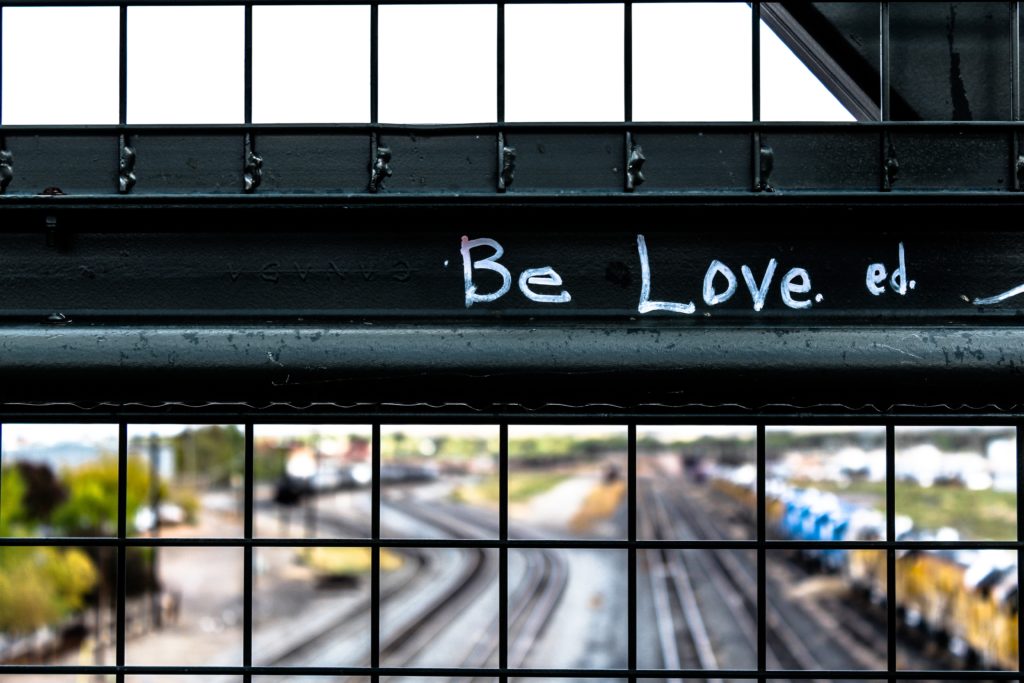This is our country. It is a land where hope and faith in tomorrow have forged a unique system of democracy which always looks forward.
From Sea to Shining Sea
Our Common Humanity
Full Steam Ahead
The Journey of Becoming
Removing Barriers To Care for Youth
Father's Day and Our Expectations
Seeking Wisdom On The Journey
Sometimes the Runner Stumbles
The Profound Effect of Childhood Trauma; A Gentle Revolution of Trauma Informed Care
The Big Questions; For Those Who Dare to Dream
Kids in Trouble; Injustice Posing as Justice in America
Transforming Cheerfulness
Forgiving Our Families
Tell Your Stories on Memorial Day
Finding My Neighbor
We become neighbors when we are willing to cross the road for one another. There is so much separation and segregation: between black people and white people, between gay people and straight people, between young people and old people, between sick people and healthy people, between prisoners and free people, between Jews and Gentiles, Muslims and Christians, Protestants and Catholics, Greek Catholics and Latin Catholics. There is a lot of road crossing to do. ~ Henri Nouwen
Who is my neighbor? The question is never satisfied with a qualified answer. For some reason we struggle with it in so many ways. Gun violence and murder in our schools, Black lives matter, Blue lives matter, and a cry of #metoo all plead the same question. It has resonated in the hearts of people for more than two thousand years. It can even be found as a scriptural directive.Bishop Michael Curry told us about the great commandment of love at the wedding of Prince Harry and Meghan Markle. He said; “Jesus of Nazareth on one occasion was asked by a lawyer to sum up the essence of the teachings of Moses, and he went back and reached back into the Hebrew scriptures to Deuteronomy and Leviticus and Jesus said you shall love the Lord your God, with all your heart, all your soul, all your mind and all your strength. This is the first and great commandment. And the second is like it: love your neighbor as yourself.”
The Good Samaritan shows us how to become a neighbor. He crosses the road to help a stranger and takes the risk of reaching out to a perceived enemy. The injured victim becomes a neighbor. He is given kindness and compassion by a stranger where he had been ignored or avoided by his own people. The neighbor generously rises above community expectations and common practice both in giving and receiving.Who is my neighbor today? Possibilities for an answer will be presented to us around every corner. We will have chances to cross the road on more than one occasion. That friend who has become an irritation is waiting for the hand of forgiveness. The young person who looked so threatening could use an encouraging word.The one who celebrates a religious practice unlike our own can be asked to lunch for an enlightening exchange of ideas. The person of another race seeks our genuine brotherhood. We cannot hope to receive love if we are not willing to give it. We cannot claim to be members of the human family if we do not rise above that which causes separation. We must cross the road and become a neighbor.
The world is waiting. Someday we will discover that everyone is our neighbor.
Robert Kenneth Jones is an innovator in the treatment of addiction and childhood abuse.In a career spanning over four decades, his work helping people recover from childhood abuse and addiction has earned him the respect of his peers.His blog, An Elephant for Breakfast, testifies to the power of the human spirit to overcome the worst of life’s difficulties. We encourage you to visit and share this rich source of healing, inspiration and meditation.
Contact Bob Jones on Linkedin
How Trauma Is Killing Us: Understanding Adverse Childhood Experiences (ACES)
“If we do not transform our pain, we will most assuredly transmit it.” ~ Richard Rohr
Another tragic mass shooting resulted in the deaths of ten people at Santa Fe High School near Houston on Friday, May 19, 2018. There have been 22 school shootings so far this year where someone was injured or died.
It is hard to comprehend. There has been more than one shooting each week. What is going on? Our children are killing each other in a very public forum at the places where nurturing, learning and growing into good citizens should be happening for them all.
Instead, the threat and fear of death and violence is following them into every classroom. Why do we adults seem powerless to put measures into effect that would change the situation immediately? We seem to be passively accepting that this is the new normal…that nobody is safe anywhere. Of course, this is not true. My sense is that we are overwhelmed and don’t understand that unimaginable pain, mental illness and trauma are culprits behind all the violence.
I have learned a lot about (and from) kids through my professional involvement over the past four decades. Even though I would love to pour all of my experiences and wisdom shared by mentors and the kids themselves regarding childhood trauma into these pages, there would never be enough room. So allow me to synthesize some of what I know about violent children and relate it to school shootings.
- Childhood trauma is an underpinning of the rage which creates horrific violence.
- Traumatized kids cannot imagine a future without more pain. Usually, they lead lives filled with current conditions of chaos and unpredictability leaving them continually re-damaged.
- Aggressive behavior is the last survival behavior a kid uses. He has already tried to find relief in every other way.
- No hopeful kid ever picked up guns or explosives, took them to school, and started a killing spree. Only hopelessness can create it.
- No kid ever thought that killing his classmates and teachers would bring him attention and fame. He just wanted to die.
"The status quo is only interested in incessant judging, comparisons, measuring, scapegoating and competition." ~ Gregory Boyle
In each case, experts have lined up to offer all kinds of solutions. Mostly they involve gun control of one kind or another on one side and the arming/hardening of schools on the other. We seem to be stuck in debates which lead to very little action. Unfortunately, almost all of the proposals are reactive. Rather than putting our efforts into primary prevention, we seem bent on expending massive resources fighting a losing battle against the NRA or by turning schools into impenetrable fortresses. I wrote a column several weeks ago about the folly of these tertiary interventions as they apply to our addiction epidemic. The same applies when it comes to this problem.
Since childhood trauma, Adverse Childhood Experiences (ACEs), seem to have a causal relationship to violence and school shootings, I believe that we can develop screening and assessment protocols to identify at-risk people and circumstances. We will then be able to change our modus operandi from blaming, shaming and punishing people to understanding, encouraging and healing them.
What are ACEs?
ACEs are Adverse Childhood Experiences. These are events which occur before age 18 (most damaging are those which happen prior to age 6) and are beyond a young person’s control. A lifetime of hardship and adversity can follow which could be passed on from generation to generation.
The principal types of ACEs are:
- Emotional, physical or sexual abuse
- Emotional and physical neglect
- Living in seriously troubled households (homes that have domestic violence, or mental and/or substance (alcohol or drug) disorders, or parental separation or divorce, or a family member who is incarcerated.
As the number of ACEs a youth experiences increase, so too does the risk for these health and mental health problems – often before they depart their teen years. The greater the number of ACEs a youth experiences, the greater is the likelihood of multiple problems. ACEs science clearly shows that childhood trauma results in adolescent and adult-onset of chronic physical and mental illness, violence, and being a victim of violence.
ACEs and the Extreme State
Most of us have been exposed to at least one ACE in our lives. But very few of us can relate to the impact of real-life, hardcore trauma experiences which cause the ‘survival brain’ to take control of our behavior. Children who have suffered cigarette burns at the hands of parents or those who are abused sexually every night endure torture which most of us cannot imagine. These events or series of events have been referred to as the extreme state by Dr. Corinne Gerwe.
Sigmund Freud theorized survival as a predominant driving factor in human behavior. When trauma is experienced it is followed by an intense feeling such as fear or anger. Physical symptoms follow like a racing heart or nausea. The survival brain goes into high gear, virtually closing down the ‘learning brain’ sensing an emergency situation. The behavior(s) which are enacted and relieve the intensity of the feeling is logged in the memory and become intrinsically linked to emotional survival. They will be continually reactivated by their inter-related feeling/physical symptom states whenever the intense feeling shows up. They can develop into persistent and often obsessive patterns that are not grounded in rational thinking or intention. They can be described as behaviors that a person will swear never to do again and yet repeat despite attempts to resist. These behaviors can be difficult to explain and even a mystery to the person enacting them as noted by Gerald M. Edelman in his 2003 study of neuronal consciousness.
Understanding ACEs and the extreme state should allow us to stop wasting time looking for scapegoats, endlessly searching for motives, slapping the dismissive labels of evil, loser, or bad guy on a person who has inflicted terrible damage. It will enable our communities to own their part in violence when little has been done to prevent it. Healing only occurs when we recognize the true nature of a problem, understand its defeating nature, and apply steps to change the way we deal with it. Prevention is the only long term solution.
“Denial is perfectly beneficial until it’s not anymore. Then we need to find a safe place to peel back the layers of our own pain.” ~ Gregory Boyle
Primary Prevention and Intervention Using ACEs
We have a golden opportunity to solve this most intractable school shooting problem as well as other less dramatic consequences of ACEs. One community where systems are in place to change the dynamic is Memphis, Tennessee. Their ACE Awareness Foundation takes a three-step approach.
- Universal Parenting Places (UPP sites) ~ UPP sites are judgment-free zones where parents can go for help. They can talk with counselors, explore their own ACEs and learn how to alter their behaviors in their homes. Counseling is offered at no cost to the consumer. Research has shown that being able to trust another adult and “just let it out” helps people work through their experiences and take control. For some adults with a high ACE score, finding out that there may be a scientific reason their minds and bodies react in certain ways can also be liberating.
- Parent Support Warm Line ~ At home, caregivers can call a free phone line (844-UPP-WARM) administered by Le Bonheur Children’s Hospital for guidance and support with parenting issues in real-time. It’s manned by licensed therapists who have trauma training. ACEs are more likely to occur during peak hours of parenting — late afternoon to bedtime — so the Warm Line is available for parents who need to talk through something or who just need a timeout.
- Community Outreach ~ Healthcare providers, organizations and civic leaders attend workshops focused on creating trauma-informed citizens. The State of Tennessee has also held statewide summits and created task forces to combat the issue, creating ACE Awareness Partners.
“We envision a Memphis where everyone knows where to get the help they need. Every adult and child should be able to take control of their own destiny.” ~ Ellen Rolfes
The more we can do to prevent ACEs, the closer we will come to ending school violence, bullying, and even mass shootings. With this in mind, I propose that every student in every school and every parent or caretaker should complete an ACEs assessment. Those who are deemed at risk would receive immediate referral and help. This is a full system change from intervention to prevention that won’t come easy. But we need to create a critical mass of people who understand ACEs, can speak that language and can take action.
The Work Has Already Begun
There are now 38 states and the District of Columbia who has done their own ACE surveys through the Behavioral Risk Factor Surveillance System (BRFSS) since 2009. The BRFSS is an ongoing data collection program designed to measure behavioral risk factors for the adult population (18 years of age or older) living in households. The original Kaiser-CDC ACE Study began in 1995 and completed in 1997, but participants were followed for 20 years. New data on the more than 17,000 participants continue to be collected.
ACEs assessments and questionnaires are being used in education, healthcare, parenting programs, and juvenile justice systems around the country. A group called ACEs Connection describes themselves as “a social network that accelerates the global movement toward recognizing the impact of adverse childhood experiences in shaping adult behavior and health, and reforming all communities and institutions -- from schools to prisons to hospitals and churches -- to help heal and develop resilience rather than to continue to traumatize already traumatized people.” They have organized concise methods for communities to start up local ACEs Networks.
Below you will find pdf downloadable tools from my Google Drive that can be used to determine ACEs risk for adults, children, and teens. Start by finding your own ACE score. Let’s join the effort to bring about some real, long-lasting change.
ACEs Toolbox; Questionnaires and User Guide
Finding Your (Adult) ACE Score
Robert Kenneth Jones is an innovator in the treatment of addiction and childhood abuse.
In a career spanning over four decades, his work helping people recover from childhood abuse and addiction has earned him the respect of his peers.
His blog, An Elephant for Breakfast, testifies to the power of the human spirit to overcome the worst of life’s difficulties. We encourage you to visit and share this rich source of healing, inspiration, and meditation.
Contact Bob Jones on Linkedin
Bob Jones’ blog An Elephant for Breakfast



